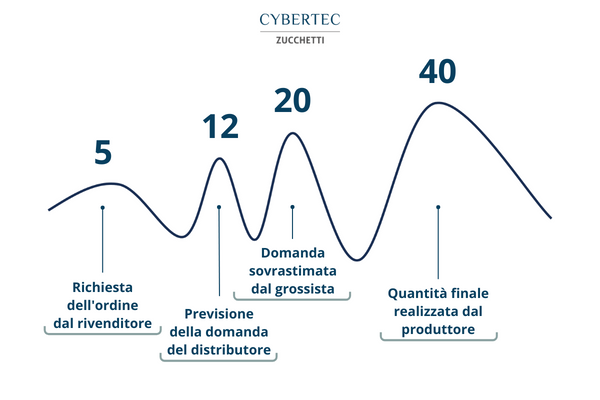The Bullwhip effect, also known as the Forrester effect (from the name of the scholar who analyzed it) or even the whip effect, is the main cause of inefficiency within supply chains and indicates the increase in demand variability as you go backwards, along the supply chain, starting from the end market.
Whatis the Bullwhip effect or Forrester effect?
Bullwhip or Forrester effect is a term that indicates a phenomenon related to the signals of demand. The analogy with the whip is due to the fact that a small movement of the wrist causes large movements of the whip, causing its end to exceed the speed of sound producing the typical noise.
Within the supply chain, a small change in demand causes a drastic change in supply. This is because in a system of closely connected actors such as the supply chain, events that represent small deviations from the average add up and amplify.
Demand is estimated from the point of sale. If demand suddenly increases or decreases and if the demand planning and forecasting system is unable to handle the change, this change can trigger a chain reaction. The next actor upstream of the supply chain will try to compensate for the variation with a certain margin, which will in turn make the next actor and so on.
The inventory can quickly change from having missing to an excess of materials. This is caused by the serial nature of the communication of orders upstream of the chain and the inherent delays due to the logistical movements of the product along the production chain. (source)
What causes the whip effect?
Let’s consider a supply chain made up of three actors (store, distributor, manufacturer) and see how the amplification of demand is generated in practice.
Product X has a daily demand of 50 units. Suddenly the customer duplicates the order, requesting 10 units. What happens to the three actors involved in the supply chain?
- The store usually has a stock of 100 units, consisting of 50 units to cover normal demand and 50 as a safety stock. When demand doubles, the store uses the safety stock to cover the increase in demand. It will then order 150 units from the distributor: 100 to cover the new demand and 50 to supply the safety stock.
- The distributor receives the store order of 150 units. To cover it, it will in turn use part of the safety stock. Subsequently, interpreting this variation in demand as a stable factor, he orders 200 units from the manufacturer, adding 50 for the safety stock.
- The manufacturer will start producing more, interpreting the increase in demand as an increase in the consumption of its products.
In this example we have considered only three actors involved, but the more complex the supply chain, the greater the amplification of the perceived demand compared to the real one.
The main element that causes the whip effect is to be found in the fact that each actor acts individually, without overall visibility based on real data:
- Lack of strategic vision in supply chain planning;
- Lack of processes and tools based on collaboration between the actors;
- Inefficient internal and external communication;
- Base the demand forecast on the supply chain transition that precedes ours;
- Price fluctuations;
- Long delivery times.
Bullwhip and MRP effect
This is a well-known aspect in the supply chain, which however is not solved by traditional Material Requirements Planning, but even amplified by them.
Unfortunately MRP has its disadvantages and the biggest flaw is the one known as’ nervousness’. The definition given by APICS is as follows: the characteristic in an MRP system that occurs when small changes in higher level records (e.g., level 0 or 1) or in the main production schedule cause significant changes in timing or quantity in lower level schedules or orders (e.g., 5 or 6).
Nervousness, or in English system nervousness, is one of the main causes of the whip effect. Unfortunately, the more nodes in the supply chain, the greater the supply chain variability and therefore the more complex the supply chains, the greater the impact of variability on delivery times, service levels and inventory levels.
In fact, the MRP is a useful tool, which today, however, can be helped by the DDMRP in the management of modern supply chains that are more complicated. For this reason, parameters have been introduced that unfortunately are sometimes confusing; each parameter distorts real demand and creates a forecast error, which increases with increasing bill levels. Added to this is the fact that the planner signal, based on the forecast, moves production orders whenever it is changed. This happens every time the MRP is launched and is an effect called system nervousness. The combination of these two effects means that the company has no visibility into what it really has to produce. Producing without visibility into the future increases stocks and stock-outs occur.

The problems of the Forrester effect
As mentioned, unfortunately the Bullwhip effect has negative consequences on supply chains, in particular:
- Excessive stock levels and upstream of the production chain;
- Frequent injections;
- Ineffective sales forecasts;
- Constantly changing production plans;
- Offsets and delays.
These are the main symptoms of the Bullwhip effect, but fortunately today there are solutions that can drastically reduce, almost nullify, this phenomenon in the manufacturing sector.
How can the Bullwhip effect be reduced? The modern DDMRP solution
DDMRP manages to avoid this phenomenon thanks to the management of materials through buffers that reduce overall variability.
More specifically, DDMRP does not replace MRP but adapts it to the needs of modern supply chains. Instead of being forecast driven like MRP, DDMRP is demand driven and uses strategic decoupling points to dampen the effect of supply and demand signal distortion leading to the bullwhip effect.
DDMRP solution benefits
The DDMRP gives real and tangible benefits to the companies that adopt it, so much so that to date hundreds of manufacturing companies have implemented it. In fact, the benefits obtained by users speak of:
- Reductions in delivery times of up to 80%;
- Stock reductions of 40%, on average;
- 30% increase in sales.
Learn how to eliminate the Bullwhip effect
Today, manufacturing companies control and eliminate the Forrester effect thanks to the use of modern and advanced Demand Driven MRP (DDMRP) software, thanks to which they can plan the supply of materials in an advanced way. Find out how to equip your company with this tool and how to integrate it perfectly within your company, ask for information from a DDMRP expert.
